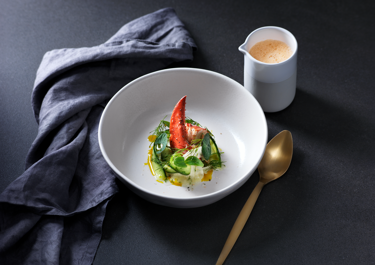Seafood bisque

A seafood bisque is a French soup packed with flavour and made from homemade seafood broth. Rich in taste and creamy in texture, this easy-to-make bisque is guaranteed to bring a taste of elegance to your dinner table. With lobster, it makes for a luxurious starter or main course that will live long in the memory.
Ingredients
Seafood bisque:
|
1
Boiled lobster
|
|
|---|---|
|
250 g
Prawn shells
|
|
|
100 g
Butter
|
|
|
½
Fennel, sliced
|
|
|
1
Yellow onion, sliced
|
|
|
¼
Celeriac, diced
|
|
|
2
Tomatoes, diced
|
|
|
2
Garlic cloves, sliced
|
|
|
2 tbsp
Tomato purée, concentrate
|
|
|
1 tsp
Cumin seed
|
|
|
200 ml
White wine vinegar
|
|
|
1 l
Water
|
|
|
500 ml
Whipped cream
|
|
|
½
Lemon
|
|
|
Salt and black pepper
|
Cucumber salad:
|
1 tbsp
Water
|
|
|---|---|
|
2 tsp
Caster sugar
|
|
|
1 tsp
Vinegar for pickling
|
|
|
1 tbsp
Olive oil
|
|
|
½ tsp
Salt
|
|
|
½
Cucumber, chopped
|
|
|
½
Fennel
|
|
|
1
Shallot
|
|
|
2 tbsp
Fresh dill, finely chopped
|
|
|
50 g
Butter
|
|
|
1 tsp
Lemon juice
|
|
|
Salt and black pepper
|
Instructions
Seafood bisque:
Cucumber salad:
Recommended information
Serving suggestion
Seafood bisque
What is the difference between stock and bisque?
Stock and bisque are both used as the culinary base for soups and sauces, however there are some differences between the two. Stock is made by simmering bones, vegetables and/or seasonings together that are then strained to create a broth used to add body and flavour to soups, stews and sauces. Bisque, on the other hand, is a seafood soup made by simmering lobster, crab or prawns together with vegetables such as onion, tomatoes, and celeriac. Cream and seasoning is often added to bisque to give it a creamy and rich texture. While stock often has a broth-like consistency.
Should a bisque be thick?
While seafood bisque typically offers a rich, creamy and smooth texture, the desired consistency and thickness (or thinness) can be adjusted to personal taste. To achieve a more broth-like consistency and lighter texture with your seafood bisque, try adding slightly less cream to the recipe. However, as cream is an important ingredient in seafood bisque and gives it its notable luxurious texture, as well as bringing balance to the flavours, removing too much cream may spoil the character of a true French classic.
How do you thicken seafood bisque?
Seafood bisque is already typically rich and creamy in flavour, but there are many things you can experiment with to add a thicker texture and consistency to your bisque. This includes adding corn starch or roux, a mixture of flour and fat, to your bisque throughout the cooking process; or simply reducing the amount of liquid by simmering your bisque on a low heat for a longer time. You can even blend some of the ingredients, such as the lobster meat or other seafood, until you get the desired consistency.
Is seafood bisque served hot or cold?
While seafood bisque is traditionally served and enjoyed as a hot meal through the colder months, there are chilled seafood bisque recipes that offer the perfect refreshing alternative for warmer climates. You’ll find chilled seafood bisque on the menu of many restaurants up and down the French riviera in the summer months.
A French seafood appetiser
Bisque is a hearty and traditional seafood soup that has its roots within French coastal and fishing towns. To this day, it remains a popular national dish across France and is one of the country’s greatest culinary exports that is enjoyed across many restaurants and homes worldwide. Though ingredients vary, the essence of the bisque remains true to its original: a rich and creamy seafood soup packed full of flavour.
An immersive seafood experience
While the history of seafood bisque may be simple its origins, used in French fishing communities as a way to preserve seafood; it soon made its way to the heights of French aristocracy and even today is still considered a dish of high taste and elegance.
Across homes worldwide, the seafood bisque has become a popular and sophisticated choice – bringing a touch of French character to the dinner table.
The flavourful bisque
Taste is everything when it comes to the perfect seafood bisque. The freshness and vibrancy of the seafood, which is textured through a rich creamy consistency, is then balanced to perfection with a range of herbs and seasonings. A taste never to forget, this French classic has remained a favourite through the centuries.
Sea you later - how to store it for another day
When refrigerated, seafood bisque can be stored for up to 4-5 days and reheated to enjoy again and again. Be sure to store it in a sealable container to avoid spoiling the rich taste that gives it its character. Reheat it slowly and over a low heat, without boiling, until it becomes piping hot.
As always, use your judgement before deciding whether to reheat and consume. The usual risks when reheating seafood should be considered and it’s important to check for any signs of expiry, such as any change in smell.









